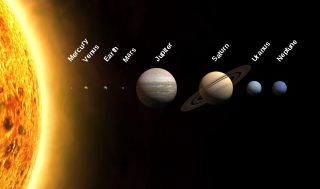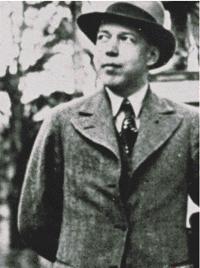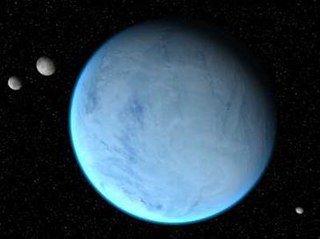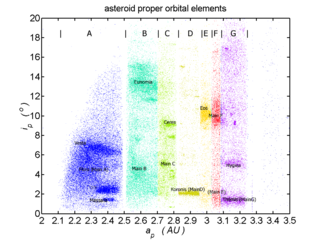
Asteroids are minor planets, especially of the inner Solar System. Larger asteroids have also been called planetoids. These terms have historically been applied to any astronomical object orbiting the Sun that did not resemble a planet-like disc and was not observed to have characteristics of an active comet such as a tail. As minor planets in the outer Solar System were discovered they were typically found to have volatile-rich surfaces similar to comets. As a result, they were often distinguished from objects found in the main asteroid belt. In this article, the term "asteroid" refers to the minor planets of the inner Solar System including those co-orbital with Jupiter.

The Solar System is the gravitationally bound planetary system of the Sun and the objects that orbit it, either directly or indirectly. Of the objects that orbit the Sun directly, the largest are the eight planets, with the remainder being smaller objects, such as the five dwarf planets and small Solar System bodies. Of the objects that orbit the Sun indirectly—the moons—two are larger than the smallest planet, Mercury.

The asteroid belt is the circumstellar disc in the Solar System located roughly between the orbits of the planets Mars and Jupiter. It is occupied by numerous irregularly shaped bodies called asteroids or minor planets. The asteroid belt is also termed the main asteroid belt or main belt to distinguish it from other asteroid populations in the Solar System such as near-Earth asteroids and trojan asteroids. About half the mass of the belt is contained in the four largest asteroids: Ceres, Vesta, Pallas, and Hygiea. The total mass of the asteroid belt is approximately 4% that of the Moon, or 22% that of Pluto, and roughly twice that of Pluto's moon Charon.

Armageddon is a 1998 American science fiction disaster film directed by Michael Bay, produced by Jerry Bruckheimer, and released by Touchstone Pictures. The film follows a group of blue-collar deep-core drillers sent by NASA to stop a gigantic asteroid on a collision course with Earth. It stars Bruce Willis and an ensemble cast comprising Ben Affleck, Billy Bob Thornton, Liv Tyler, Owen Wilson, Will Patton, Peter Stormare, William Fichtner, Michael Clarke Duncan, Keith David, and Steve Buscemi.

Apt Pupil is a 1998 American psychological thriller film directed and co-produced by Bryan Singer and written by Brandon Boyce. The film, which stars Ian McKellen and Brad Renfro, is based on the 1982 novella of the same name by Stephen King. Set in the 1980s in southern California, the film tells the fictional story of high school student Todd Bowden (Renfro), who discovers a fugitive Nazi war criminal, Kurt Dussander (McKellen), living in his neighborhood under a pseudonym. Bowden, obsessed with Nazism and the Holocaust, persuades Dussander to share his stories, and their relationship stirs malice in each of them. Singer has called Apt Pupil "a study in cruelty", with Nazism serving as a vehicle to demonstrate the capacity of evil.

Mika Toimi Waltari was a Finnish writer, best known for his best-selling novel The Egyptian. He was extremely productive, and wrote in addition to novels also poetry, short stories, crime novels, plays, essays, travel stories, film scripts and rhymed texts for comic strips.

Hoth is an ice planet in the Star Wars fictional universe. It first appeared in the 1980 film The Empire Strikes Back and has also been a setting in Star Wars books and video games.

Catherine Ann Asaro is an American science fiction and fantasy author. She is best known for her books about the Ruby Dynasty, called the Saga of the Skolian Empire.

Charles David George "Charlie" Stross is a British writer of science fiction, Lovecraftian horror, and fantasy. Stross specialises in hard science fiction and space opera. Between 1994 and 2004, he was also an active writer for the magazine Computer Shopper and was responsible for the monthly Linux column. He stopped writing for the magazine to devote more time to novels. However, he continues to publish freelance articles on the Internet.

The Hilda asteroids (adj. Hildian) are a dynamical group of more than 4000 asteroids located beyond the asteroid belt in a 3:2 orbital resonance with Jupiter. The namesake is the asteroid 153 Hilda. Hildas move in their elliptical orbits so that their aphelia put them opposite Jupiter (at L3), or 60° ahead of or behind Jupiter at the L4 and L5 Lagrangian points. Over three successive orbits each Hilda asteroid approaches all of these three points in sequence. A Hilda's orbit has a semi-major axis between 3.7 and 4.2 AU (the average over a long time span is 3.97), an eccentricity less than 0.3, and an inclination less than 20°. Two collisional families exist within the Hilda group: the Hilda family and the Schubart family. The namesake for the latter family is 1911 Schubart.

Nancy Anne Kress is an American science fiction writer. She began writing in 1976 but has achieved her greatest notice since the publication of her Hugo and Nebula-winning 1991 novella Beggars in Spain, which she later expanded into a novel with the same title. She has also won the Nebula Award for Best Novella in 2013 for After the Fall, Before the Fall, During the Fall, and in 2015 for Yesterday's Kin.

Marc William Buie is an American astronomer and prolific discoverer of minor planets, who used to be at Lowell Observatory in Flagstaff, Arizona, and also the Sentinel Space Telescope Mission Scientist for the B612 Foundation, which is dedicated to protecting Earth from asteroid impact events. In 2008 Marc Buie moved to Boulder, Colorado to work at the Southwest Research Institute in the Space Science Department.

An asteroid family is a population of asteroids that share similar proper orbital elements, such as semimajor axis, eccentricity, and orbital inclination. The members of the families are thought to be fragments of past asteroid collisions. An asteroid family is a more specific term than asteroid group whose members, while sharing some broad orbital characteristics, may be otherwise unrelated to each other.

Lucius Shepard was an American writer. Classified as a science fiction and fantasy writer, he often leaned into other genres, such as magical realism. His work is infused with a political and historical sensibility and an awareness of literary antecedents.

Main-belt comets (MBCs) are bodies orbiting within the asteroid belt that have shown comet-like activity during part of their orbit. The Jet Propulsion Laboratory defines a main-belt asteroid as an asteroid with a semi-major axis of more than 2 AU but less than 3.2 AU, and a perihelion of no less than 1.6 AU. David Jewitt from UCLA points out that these objects are most likely not comets with sublimating ice, but asteroids that exhibit dust activity, and hence he and others started calling these class of objects active asteroids. The first main-belt comet discovered is 7968 Elst–Pizarro. It was discovered in 1979 and was found to have a tail by Eric Elst and Guido Pizarro in 1996 and given the cometary designation 133P/Elst-Pizarro.
Asteroids and asteroid belts are a staple of science fiction stories. Asteroids play several potential roles in science fiction: as places which human beings might colonize; as resources for extracting minerals; as a hazard encountered by spaceships traveling between two other points; and as a threat to life on Earth due to potential impacts

As the largest body in the asteroid belt, the dwarf planet Ceres frequently appears in science fiction:

A minor planet is an astronomical object in direct orbit around the Sun that is neither a planet nor exclusively classified as a comet. Before 2006 the International Astronomical Union (IAU) officially used the term minor planet, but during that year's meeting it reclassified minor planets and comets into dwarf planets and small Solar System bodies (SSSBs).



















